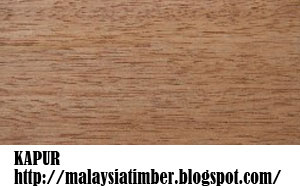Scientific name
Dryobalanops spp. principally D.aromatica. Family: Myrtaceae
Local names
Kapor, Borneo camphorwood, keladan (Sarawak), kapoer (Indonesia), belakan, kamfer.
Description and natural occurrence
Large hardwood to 45 m with a straight, cylindrical bole, and well-formed buttresses. Occurs in lowland tropical rainforests of Malaysia, Indonesia and South-East Asia, often in almost pure stands. Bark is grey brown or dark brown with shallow fissures. Diameter of logs is between 80 and 100 cm. Freshly cut trees have a camphor-like odour.
Wood appearance
Colour. Sapwood ranges from almost white to yellow-brown and is clearly distinct from the heartwood. Heartwood is red or red-brown.
Grain. Grain variable from straight to interlocked or spiral. Texture coarse but even. Growth rings absent.
Wood properties
Density. 800 kg/m3 at 12% moisture content; approximately 1.3 m3 of seasoned sawn timber per tonne.
Termite resistance. Not resistant.
Preservation. Sapwood accepts preservative impregnation.
Seasoning. Slow to dry, usually with very little degrade.
Hardness. Moderately hard (rated 3 on a 6 class scale) in relation to indentation and ease of working with hand tools.
Machining. Machines well with a moderate blunting effect on cutting edges caused by the presence of silica.
Fixing. Pre-drilling recommended when nailing near extremities, otherwise nailing and screwing characteristics are good.
Gluing. Care needed when using urea-formaldehyde and phenol-formaldehyde adhesives.
Finishing. Stains, paints and polishes satisfactorily.
Uses
Construction. Stairways, flooring, general construction.
Decorative. Plywood, furniture, joinery, lining.
Others. Sawn shingles, packing cases, boat building, pallets, tool handles.
Identification features
Sapwood. Well defined from heartwood.
Heartwood. Red to red-brown in colour.
Texture. Coarse, uniform. Grain variable from straight to interlocked or spiral.
Vessels. Predominantly solitary, medium to large in size, visible to the unaided eye. Tyloses common. Vessel lines present.
Parenchyma. Apotracheal as irregular spaced concentric bands and some diffuse strands.
Rays. Fine to medium size, visible through lens.


